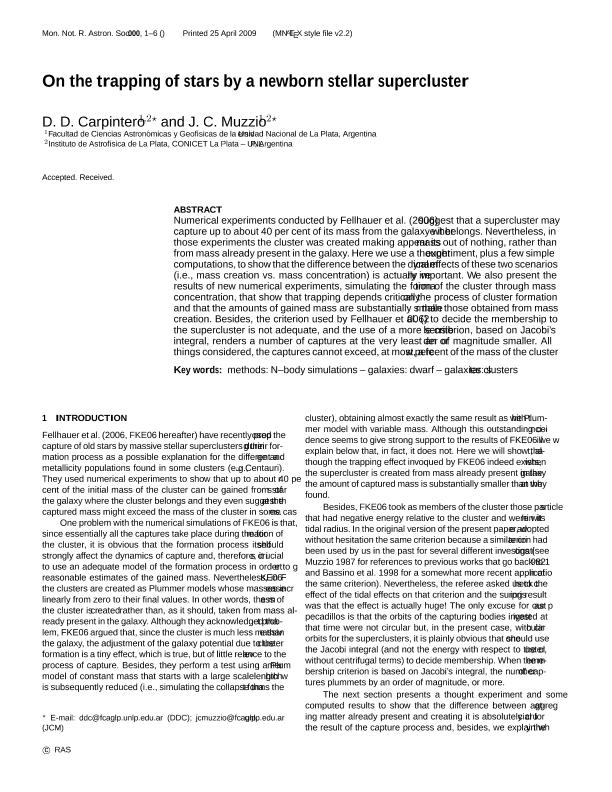Mostrar el registro sencillo del ítem
dc.contributor.author
Carpintero, Daniel Diego

dc.contributor.author
Muzzio, Juan Carlos

dc.date.available
2018-04-20T18:02:20Z
dc.date.issued
2009-12
dc.identifier.citation
Carpintero, Daniel Diego; Muzzio, Juan Carlos; On the trapping of stars by a newborn stellar supercluster; Wiley Blackwell Publishing, Inc; Monthly Notices of the Royal Astronomical Society; 397; 2; 12-2009; 1021-1026
dc.identifier.issn
0035-8711
dc.identifier.uri
http://hdl.handle.net/11336/42886
dc.description.abstract
Numerical experiments conducted by Fellhauer et al. (2006) suggest that a supercluster may capture up to about 40 per cent of its mass from the galaxy where it belongs. Nevertheless, in those experiments the cluster was created making appear its mass out of nothing, rather than from mass already present in the galaxy. Here we use a thought experiment, plus a few simple computations, to show that the difference between the dynamical effects of these two scenarios (i.e., mass creation vs. mass concentration) is actually very important. We also present the results of new numerical experiments, simulating the formation of the cluster through mass concentration, that show that trapping depends critically on the process of cluster formation and that the amounts of gained mass are substantially smaller than those obtained from mass creation. Besides, the criterion used by Fellhauer et al. (2006) to decide the membership to the supercluster is not adequate, and the use of a more sensible criterion, based on Jacobi’s integral, renders a number of captures at the very least an order of magnitude smaller. All things considered, the captures cannot exceed, at most, a few percent of the mass of the cluster.
dc.format
application/pdf
dc.language.iso
eng
dc.publisher
Wiley Blackwell Publishing, Inc

dc.rights
info:eu-repo/semantics/openAccess
dc.rights.uri
https://creativecommons.org/licenses/by-nc-sa/2.5/ar/
dc.subject
N-Body Simulations
dc.subject
Dwarf Galaxies
dc.subject
Star Clusters
dc.subject.classification
Astronomía

dc.subject.classification
Ciencias Físicas

dc.subject.classification
CIENCIAS NATURALES Y EXACTAS

dc.title
On the trapping of stars by a newborn stellar supercluster
dc.type
info:eu-repo/semantics/article
dc.type
info:ar-repo/semantics/artículo
dc.type
info:eu-repo/semantics/publishedVersion
dc.date.updated
2018-04-19T18:32:05Z
dc.journal.volume
397
dc.journal.number
2
dc.journal.pagination
1021-1026
dc.journal.pais
Reino Unido

dc.journal.ciudad
Oxford, Reino Unido
dc.description.fil
Fil: Carpintero, Daniel Diego. Universidad Nacional de La Plata. Facultad de Ciencias Astronómicas y Geofísicas; Argentina. Consejo Nacional de Investigaciones Científicas y Técnicas. Centro Científico Tecnológico Conicet - La Plata. Instituto de Astrofísica La Plata. Universidad Nacional de La Plata. Facultad de Ciencias Astronómicas y Geofísicas. Instituto de Astrofísica La Plata; Argentina
dc.description.fil
Fil: Muzzio, Juan Carlos. Universidad Nacional de La Plata. Facultad de Ciencias Astronómicas y Geofísicas; Argentina. Consejo Nacional de Investigaciones Científicas y Técnicas. Centro Científico Tecnológico Conicet - La Plata. Instituto de Astrofísica La Plata. Universidad Nacional de La Plata. Facultad de Ciencias Astronómicas y Geofísicas. Instituto de Astrofísica La Plata; Argentina
dc.journal.title
Monthly Notices of the Royal Astronomical Society

dc.relation.alternativeid
info:eu-repo/semantics/altIdentifier/doi/http://dx.doi.org/10.1111/j.1365-2966.2009.15024.x
dc.relation.alternativeid
info:eu-repo/semantics/altIdentifier/url/https://academic.oup.com/mnras/article/397/2/1021/972681
Archivos asociados
